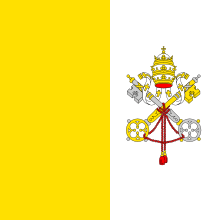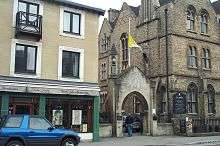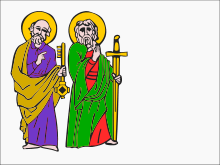Flag of Vatican City
The flag of Vatican City was adopted on 7 June 1929, the year Pope Pius XI signed the Lateran Treaty with Italy, creating a new independent state governed by the Holy See. The Vatican City flag is modeled on the 1808 yellow and white flag of the earlier Papal States, to which a papal tiara and keys were later added. The Vatican (and the Holy See) also refers to it, interchangeably, as the flag of the Holy See.[1]
 | |
| Use | National flag |
|---|---|
| Proportion | 1:1 |
| Adopted | 7 June 1929 |
| Design | A vertical bicolour of gold and white, charged with the coat of arms centred on the white portion |
Description
The flag consists of two vertical bands, one of gold or yellow (hoist side) and one of white with the crossed keys of Saint Peter and the Papal Tiara centered in the white band. The crossed keys consist of a golden and a silver key, in which the silver key is placed in the dexter position. It is one of only two square sovereign-state flags, the other being the flag of Switzerland.
The coat of arms of Vatican City is present in the white half. The coat of arms consists of:
- the papal tiara (as used under the pontificate of Pius XI);
- the two keys which represent the Keys of Heaven (according to the Gospel of Matthew 16:19) given by Jesus Christ to St Peter. The popes are regarded as the successor of Peter, and the gold and silver keys have been significant elements in the symbolism of the Holy See since the 13th century. The gold represents spiritual power, while the silver key represents worldly power. The order of the keys on the coat of arms of Vatican City is the reverse of the coat of arms of the Holy See, in order to distinguish between the two entities.
- a red cord connecting the keys.
The yellow and white of the flag also refer to the keys – in heraldic terminology, there is no distinction between yellow and gold (the metallic color or), nor between white and silver (argent). The Argent color has also been reported in relation with the white mountains of Lebanon and of the biblical city of Miye ou Miye according to the Lebanese Historian Anis Freiha.
Usage
The flag is displayed in many Catholic churches and institutions worldwide, often alongside the national flag of where the church or institution is located.
History

The Papal States traditionally used a yellow and red cockade, the traditional colors of the Roman Senate and the Roman people. However, these colors were not used on flags.[2] In 1808 Pope Pius VII ordered the Vatican's Noble Guard and other troops to replace red color with white, in order to distinguish them from the troops that had been incorporated into Napoleon's army.[3]
In 1803, the Papal States started using a white merchant flag with the Papal coat of arms in the centre. This flag was made official on 7 June 1815. On 17 September 1825, it was replaced with a yellow and white flag which took its colours from the materials of the key (yellow for gold, white for silver).[4] These colors were probably taken from the 1808 flag of the Palatine guard.[4] This was the first bicolour used by the Papal States and the ancestor of the modern flag of Vatican City.[5] The merchant flag also served as a state flag on land.[4]
Starting in 1831, the papal infantry flew square yellow and white flags. At first, they were diagonally divided, but after 1849 they were vertically divided like the merchant flag. The last infantry colour, adopted in 1862, was a plain square white and yellow flag.[5]
On 8 February 1849, while Pope Pius IX was in exile in Gaeta, a Roman Republic was declared. The new government's flag was the Italian tricolor with the motto "Dio e Popolo" on the central stripe. The papal government and its flags were restored on 2 July 1849. On 20 September 1870, the Papal States were conquered by Italy and the yellow and white flags fell out of official use.
After the Lateran Treaty was signed in 1929, papal authorities decided to use the 1825 merchant flag as the state flag of the soon to be independent Vatican City state. However, the official drawing in the constitution used a drawing of the square 1862 infantry flag as a template. The treaty came into effect on 7 June 1929, and with it the newly-square Vatican flag.[6]
Gallery
.svg.png)
Colours of the Papal States, used at various intervals between 754–1803[lower-alpha 1]

Banner of Pope Alexander VI (Pesaro Madonna variant)

Flag with Medici arms, as used by Pope Leo X

Variant attested in the 1520s

Flag of the Papacy used by Pope Paul III, as shown in the Palazzo Farnese
.svg.png)
Flag of the Papal States, 1803–1825
.svg.png)
Flag of the Papal States, 1825-1849, 1849–1870
.svg.png)
Flag of the Roman Republic, 1849
.svg.png)
Papal Infantry Flag, 1862-1870

The flag taken to the Moon by Apollo 11, displayed in the Vatican Museums alongside moon rocks
.svg.png)
2:3 variant of the Flag of Vatican City[7]
_IMG_9357.jpg)
Lapel model.

Flag of the Papal Navy, depicting Saints Peter and Paul, pre-19th century.
See also
- List of flags of the Papacy
- History of Christian flags
- Christian Flag
- Index of Vatican City-related articles
Notes
- Also the de facto flag of the medieval Commune of Rome.
References
- "United Nations to Raise Holy See Flag on September 25". En.radiovaticana.va. Retrieved 2015-10-20.
- "Vatican - Historical Flags" at Flags of the World
- "Bandiera pontificia" (in Italian). Stato della cità del Vaticano. Archived from the original on 2008-10-15. Retrieved 2008-07-09.
Anticamente la bandiera dello Stato pontificio era giallorossa (o per meglio dire amaranto e rossa, colori derivati dai colori dello stemma della Santa Sede), i due colori tradizionali del Senato e del Popolo romano, che vennero tuttavia sostituiti con il bianco e il giallo nel 1808, allorché Pio VII
- Breschi, Roberto. "Stato Pontifico" (in Italian). Retrieved 9 February 2014.
- Becker, Rev. William M. "Flag of Vatican City". Retrieved 9 February 2014.
- Becker, Rev. Dr. William M. (Jan–Mar 2012). "The Vatican Flag: Proportions & Alternatives" (PDF). NAVA News. Trenton, New Jersey: North American Vexillological Association. Retrieved 9 February 2014.
- "Archived copy". Archived from the original on 2015-09-27. Retrieved 2015-08-10.CS1 maint: archived copy as title (link)
External links
| Wikimedia Commons has media related to Flags of the Vatican City. |
- Vatican City at Flags of the World
- Flag of Vatican City by Rev. William M. Becker

